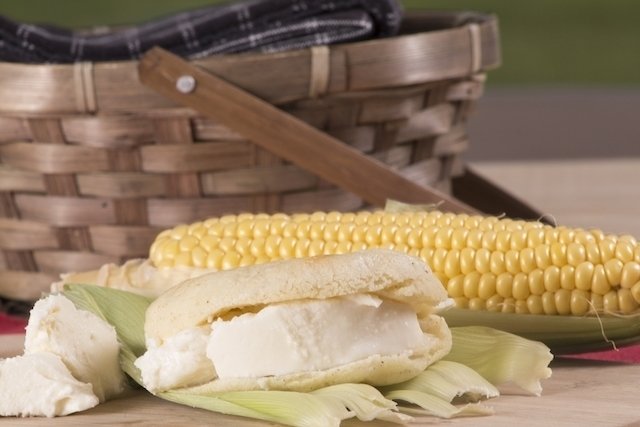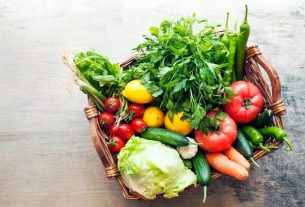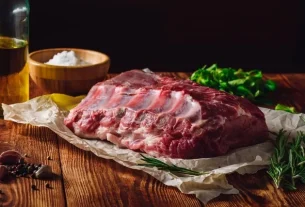Arepa is a food made from pre-cooked corn flour or ground dry corn and, therefore, is an excellent food that can be included in several meals throughout the day, such as breakfast, lunch or dinner. This type of food is very typical of Venezuela and Colombia, being another option to replace bread.
This food is an excellent source of energy and, despite being a carbohydrate, it can be included in the menu of a healthy diet.
To get the best benefits, you should try to increase their fiber content by choosing fillings that are low in fat and include healthy foods. Therefore, a good option is to add oats, flaxseeds or even some chopped vegetables, such as carrots or even beets, to the recipe.
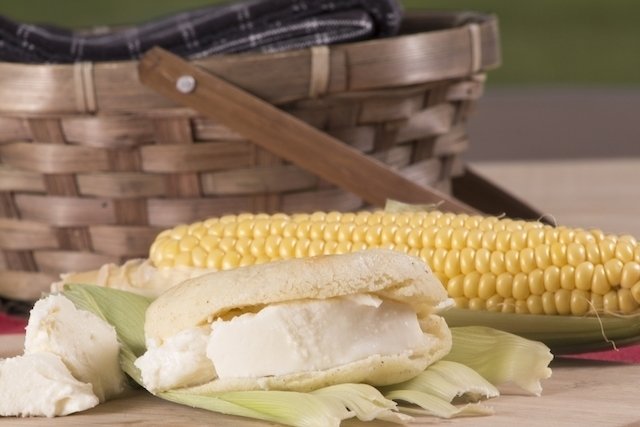
Benefits of arepa
The main health benefits of arepa are:
- Provide energyas it is rich in carbohydrates, providing energy for the body to function;
- Gluten-freebeing an excellent option to replace bread if the person has celiac disease or gluten intolerance;
- Contains low amount of sodiumbeing ideal for those who need to eat a low-salt diet;
- Does not need to be prepared with oilas they can be consumed roasted;
- Has fiber, mainly insoluble, so that it helps to speed up intestinal transit and increase the volume of feces, acting as a natural laxative and preventing constipation. Furthermore, during its preparation, it is possible to increase its amount of fiber by adding rolled oats, grated vegetables or seeds to the dough, for example;
- No preservativescoloring or flavoring.
Furthermore, arepa is a very versatile food, as it can be combined with different fillings, serving different meals of the day, as well as different preferences.
Does an arepa make you fat?
It dependsas the arepa is rich in carbohydrates, providing energy for the body, which means that if consumed in large quantities, if prepared with little fiber and/or if the filling is unhealthy, it can promote weight gain.
However, it is possible to add more fiber to the flour when preparing it, by adding 2 tablespoons of sliced oats, 2 tablespoons of linseed or chia seeds or some grated vegetable such as carrots, beets, zucchini, spinach or peppers, for example. This way, the pasta will be rich in fiber and increase the feeling of satiety, as well as lowering your glycemic index, helping to regulate blood sugar levels.
In some countries it is possible to obtain pre-cooked whole grain versions of corn flour, so this could be another way to prepare arepas in a healthy way and with a higher fiber content.
Nutritional information
The following table shows nutritional information for every 100 grams of arepa:
It is important to keep in mind that the arepa’s nutritional information, including its calorie content, may vary depending on the filling used, which could make it more caloric.
Recipe for making arepas

The recipe for making arepas is relatively simple, as you only need to mix corn flour, water and salt. It is recommended that each arepa weighs between 60 and 90 grams and ideally it should be consumed once a day.
Arepas can be stuffed with simple foods, such as grated white cheese, but they can also be stuffed with meat, when they are to be used for lunch or dinner, for example.
Ingredients
- 1 ¼ cup of water;
- 1 cup of pre-cooked corn flour;
- 1 teaspoon of salt;
- 1 tablespoon of oats, flaxseed or chia (optional);
- Grated carrot, beetroot, pepper or zucchini (optional).
Preparation mode
Pour the water into a container and then add the salt, stirring, until completely dissolved. Then add the corn flour little by little, stirring until you get a smooth dough. The dough should rest for about 3 minutes.
If the dough is too dry or hard, you can add a little more water. If, on the contrary, it is too soft, you can add a little more flour.
Finally, divide the dough into 5 portions and form small balls, which must be kneaded until you obtain discs measuring around 10 cm in diameter. To cook the arepa, it is recommended to place it on a metal board over medium heat for 5 minutes on each side, until golden.
Healthy arepa filling recipes
Various types of fillings can be used to fill the arepas. Some of the healthiest are:
1. Reina pepiada light
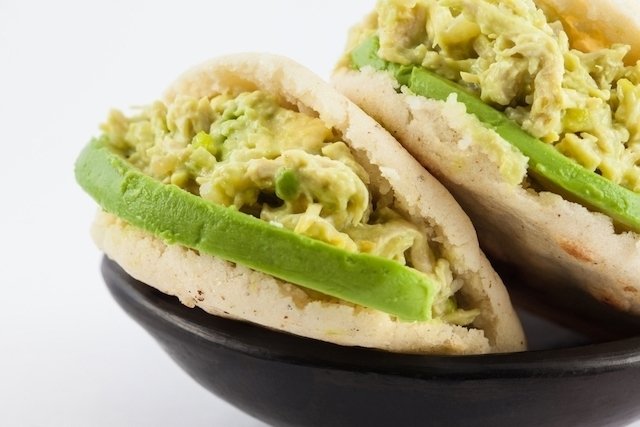
Reina pepiada is one of the most popular fillings in Venezuela and Colombia prepared with avocado and mayonnaise. However, to make it healthier, mayonnaise can be replaced with natural yogurt, for example.
Ingredients
- 1 kg of chicken;
- Pulp of 2 medium ripe avocados;
- 1 natural yogurt;
- ½ chopped onion;
- 1 clove of garlic;
- ½ lemon;
- Salt and pepper to taste.
Preparation mode
Place the water and a pinch of salt in a pan and bring to a boil. Then add the chicken until cooked. Remove the chicken and let it cool. Shred the chicken into small pieces, removing the bones and skin.
Common mixer or a blender, blend the avocado pulp, onion and garlic clove until it forms a homogeneous paste. Finally, add the shredded chicken, yogurt, lemon, salt and pepper to taste.
2. Scrambled eggs with tomato
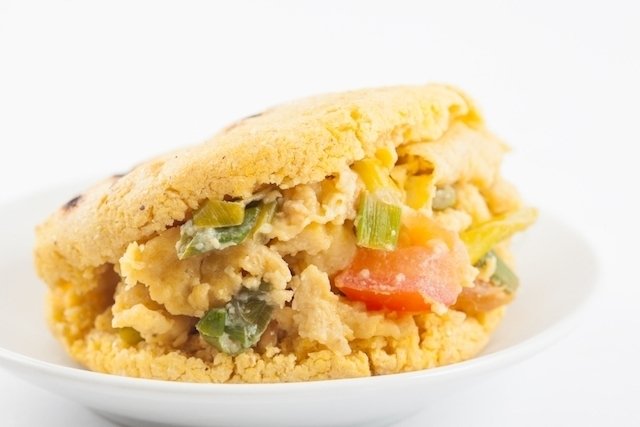
This is another of the most typical fillings for arepas that is quite simple to prepare and healthy.
Ingredients
- 1 ripe tomato, chopped into cubes;
- ½ chopped onion;
- 4 strips of chopped green pepper;
- 3 eggs;
- Salt and pepper to taste;
- Corn oil.
Preparation mode
Add a few drops of corn oil to a frying pan and add the onion and pepper, letting them brown over medium heat. Then add the tomato and mix. Add the beaten eggs, salt and pepper to taste, mixing until completely cooked.
3. Vegetarian
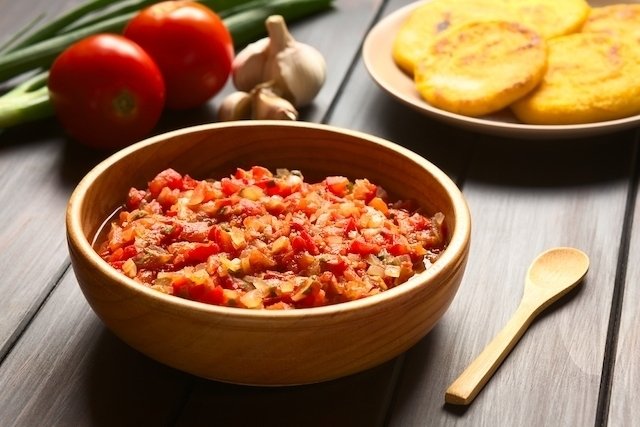
This filling is a great option for those who are vegetarian or even veganas it is made from vegetables, not including products of animal origin.
Ingredients
- 100 grams of chopped chives;
- 2 ripe and chopped tomatoes;
- ½ chopped onion;
- ½ chopped garlic;
- 1 pinch of cumin;
- 2 tablespoons of olive oil, corn or sunflower oil;
- Salt and pepper to taste.
Preparation mode
Add a few drops of corn oil to a frying pan and add the onion, chives and cumin, letting them brown over medium heat. When the vegetables are transparent, add the tomato and heat everything again for another 10 minutes.
Finally, add salt and pepper to taste, mixing for another 10 minutes until the mixture turns into a thick sauce.

Sign up for our newsletter and stay up to date with exclusive news
that can transform your routine!
Warning: Undefined array key "title" in /home/storelat/public_html/wp-content/plugins/link-whisper-premium/templates/frontend/related-posts.php on line 12
Warning: Undefined array key "title_tag" in /home/storelat/public_html/wp-content/plugins/link-whisper-premium/templates/frontend/related-posts.php on line 13

